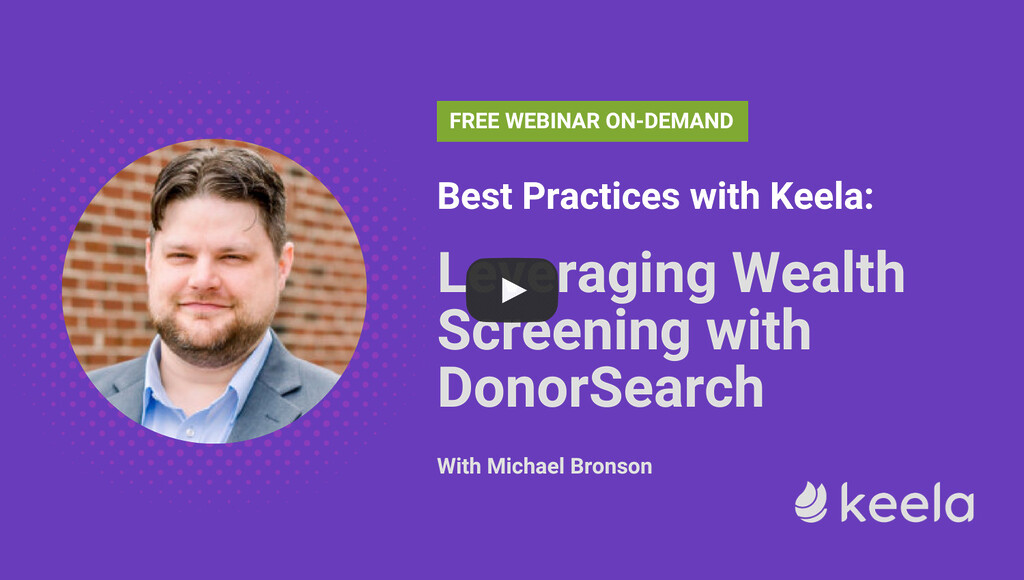The Power of Donor Stewardship: Cultivating Lifelong Supporters for Nonprofits


In the realm of nonprofit organizations, success is not solely measured in dollars raised, but rather in the lives touched and the communities transformed. At the heart of this transformative work lies a crucial practice: donor stewardship.
Donor stewardship, a term that carries profound significance in the nonprofit sector, encompasses the strategies and actions taken to build and maintain strong relationships with supporters. It’s more than a mere administrative process—it’s an art form, a commitment to valuing the trust and investment of those who believe in your cause.
In this article, we will delve into the very essence of donor stewardship, unlocking its potential as a cornerstone of successful nonprofit endeavors. By the time you finish reading, you’ll not only understand the intricacies of this vital practice but also appreciate why it is a linchpin for any thriving nonprofit organization.
In a landscape where causes compete for attention and resources, effective stewardship practices are not just beneficial—they are imperative. They lay the foundation for sustained support, allowing nonprofits to not only weather storms but to flourish and expand their impact.
Join us on this journey as we explore the profound influence of donor stewardship, uncovering the methods and strategies that pave the way for cultivating lifelong supporters. Together, we’ll discover how small gestures and thoughtful interactions can lead to a legacy of unwavering dedication to your organization’s mission.
Let’s embark on this transformative expedition, where the power of genuine connection meets the altruism that drives us all.
Understanding Donor Stewardship
When it comes to the vitality of a nonprofit, understanding the intricacies of donor stewardship is akin to holding the keys to a wellspring of sustainable support. Let’s delve into the core principles of this practice and uncover the profound benefits it brings to nonprofit organizations.
What Is Donor Stewardship?
At its essence, donor stewardship is a comprehensive approach to building and nurturing relationships with supporters. It’s not limited to expressing gratitude for a contribution—it’s about forging a meaningful connection, cultivating trust, and ensuring that donors feel valued and appreciated.
Core Principles of Donor Stewardship:
- Gratitude and Appreciation: Expressing genuine thanks is the cornerstone of stewardship. It goes beyond a simple acknowledgment; it’s about making donors feel seen and understood.
- Transparency and Accountability: Demonstrating how their contributions are making a tangible difference reinforces trust. Donors want to know that their investment is driving meaningful change.
- Effective Communication: Timely, personalized, and relevant communication keeps donors engaged and informed about your organization’s progress and impact.
- Recognition of Individuality: Recognize that each donor is unique. Tailor your interactions to their preferences and interests, showing them that their support is valued on a personal level.
Long-term Benefits of Effective Stewardship:
The impact of donor stewardship stretches far beyond the immediate financial support. It lays the foundation for a host of long-term advantages:
- Sustained Support: Cultivating strong relationships leads to ongoing commitment. Donors who feel connected are more likely to continue their support over time.
- Increased Lifetime Value: Loyal donors tend to give more over their lifetime compared to one-time contributors. Effective stewardship can significantly increase their overall impact.
- Advocacy and Referrals: Engaged donors become ambassadors for your cause. They’re more likely to spread the word and bring in new supporters, expanding your network.


Build Your Nonprofit’s Donor Stewardship Plan
Stewardship activities are touchpoints for nurturing your donors and helping to increase your donor retention rate. With this FREE template, you can map out your donor stewardship plan.
The Donor Lifecycle
Understanding the stages of the donor lifecycle is key to tailoring your stewardship efforts effectively. It encompasses the journey from initial contact to becoming a lifelong advocate.
1. Acquisition: This is the introduction phase, where a potential donor first learns about your organization. Stewardship at this stage involves making a positive first impression, demonstrating your mission’s relevance, and building trust.
2. Cultivation: Here, you’re nurturing the relationship, providing more information about your work, and understanding the donor’s interests. Personalized communication and demonstrating impact are crucial in this phase.
3. Solicitation: This is where you make the ask for support. Effective stewardship ensures that the donor understands the specific impact their contribution will have and feels confident in their decision.
4. Acknowledgement and Recognition: Prompt and heartfelt acknowledgment reinforces the value of the donor’s contribution. Recognition can be public or private, depending on the donor’s preferences.
5. Retention: Maintaining the connection and showing continued appreciation is essential. Regular updates on how their support is making a difference keeps the donor engaged and committed.
By recognizing the significance of each stage and implementing thoughtful stewardship practices, you’re not only fostering a culture of giving but also creating a path towards lifelong support for your organization.
The Benefits of Donor Stewardship
Now that you have a solid grasp of what donor stewardship entails, let’s explore the myriad benefits it brings to the table. From the concrete gains in financial support to the intangible yet equally vital aspects of loyalty and community backing, the impact of effective stewardship is far-reaching.
1. Increased Donations
The most palpable benefit of donor stewardship is the positive impact on your organization’s financial health. By making donors feel valued and appreciated, you foster a sense of trust that encourages them to continue supporting your cause. This can lead to not only larger individual contributions but also a higher likelihood of repeat donations.
2. Loyalty and Long-Term Support
A loyal donor is a cornerstone of sustainability for any nonprofit. Through effective stewardship, you’re not just securing one-time gifts; you’re cultivating a group of dedicated supporters who are more likely to stand by your side for the long haul. This loyalty translates into a steady stream of support, even in challenging times.
3. Community Support and Advocacy
Donor stewardship extends beyond individual contributors. It ripples out to the community at large. When donors feel a strong connection to your cause, they become ambassadors, spreading the word and mobilizing others to join your mission. This network effect can lead to a groundswell of support and heightened visibility for your organization.
By prioritizing relationships and consistently demonstrating the impact of contributions, these organizations not only secured vital financial support but also built a community of fervent advocates.
Leveraging Data for Stewardship
In today’s digital age, the power of data cannot be overstated, especially when it comes to donor stewardship. Understanding and effectively utilizing donor information is a game-changer in building and maintaining meaningful relationships. Let’s explore how you can harness the potential of data for your nonprofit’s stewardship efforts.
Understanding Donor Data
Importance of Data in Donor Stewardship:
Data serves as the bedrock of effective stewardship. It allows you to personalize interactions, tailor communications to donor preferences, and track engagement patterns. This, in turn, helps you build stronger connections and demonstrate the impact of their contributions in a way that resonates with each individual supporter.
Collecting and Managing Donor Information:
- Consent and Transparency: Start by ensuring that you have explicit consent to collect and use donor data. Be transparent about how you’ll use the information and provide an opt-out option if they wish to restrict certain uses.
- Centralized Database: Implement a robust donor management system that centralizes all relevant information. This not only streamlines your stewardship efforts but also enables you to track and analyze donor interactions effectively.
- Segmentation and Categorization: Group donors based on shared characteristics or behaviors. This allows you to tailor your communications to specific segments, increasing their relevance and impact.
The Role of Wealth Screening
Defining Wealth Screening:
Wealth screening is a strategic process that involves evaluating a donor’s financial capacity to make significant contributions. It goes beyond the surface-level giving history and explores an individual’s financial standing, assets, and philanthropic interests.
Purpose in Nonprofit Fundraising:
Wealth screening is a powerful tool for identifying potential major donors within your supporter base. By understanding the capacity of your donors, you can focus your efforts on cultivating relationships with those who have the means to make substantial contributions.
Integration with Keela:
Tools like Keela offer seamless integration with wealth screening tools, providing your organization with a comprehensive view of your donors. This integration allows you to not only access wealth insights but also leverage them in your stewardship strategies.
By incorporating wealth screening into your stewardship practices, you’re able to pinpoint supporters who have the capacity to make a significant impact on your mission. This targeted approach not only maximizes your fundraising efforts but also ensures that you’re nurturing relationships with donors who have the potential to become long-term champions of your cause.
Implementing Effective Donor Stewardship
Now that you have a solid foundation in understanding donor data, let’s dive into practical strategies for putting this knowledge into action. Implementing effective donor stewardship is about creating meaningful connections, expressing genuine gratitude, and keeping donors engaged in your mission. Here’s how you can do it:
Building Personalized Relationships
Tips for Personalizing Interactions:
- Segmentation and Customization: Use donor data to segment your supporter base. Tailor your communications based on their giving history, interests, and preferences. This shows that you value them as individuals, not just as donors.
- Active Communication: Regularly engage with your donors through various channels – emails, newsletters, social media, and even personalized phone calls. Keep them informed about your organization’s progress and the impact of their contributions.
- Utilize Keela’s Donor Management Features: Keela offers powerful donor management features that enable you to track interactions, preferences, and engagement history. This data empowers you to create highly personalized and targeted outreach efforts.
Acknowledging Donor Contributions
The Significance of Thank-You Gestures:
Timely and heartfelt expressions of gratitude are more than just courtesy—they’re a cornerstone of effective donor stewardship.
Best Practices for Appreciation:
- Personalized Thank-You Notes: Handwritten notes or personalized emails go a long way in making donors feel valued. Mention specific contributions and highlight the impact it will have on your mission.
- Acknowledgment Events: Consider hosting special events or gatherings to recognize and celebrate your donors. This provides an opportunity for face-to-face interaction and reinforces their connection to your cause.
- Keela’s Streamlined Acknowledgment Process: Keela’s features allow for easy tracking and scheduling of acknowledgments. This ensures that no donor goes unnoticed, and every contribution is met with a prompt and sincere thank-you.


Turn Your Donors into Lifelong Supporters with Personalized Thank-You Letters!
Proper stewardship practices such as expressing gratitude to your donors can help increase donor engagement. We have created customizable templates to help get you started!
Ongoing Engagement
Strategies for Sustained Engagement:
- Storytelling for Impact: Share compelling stories about the beneficiaries of your programs. Show donors the real-world difference their contributions are making. This emotional connection strengthens their commitment.
- Regular Updates and Progress Reports: Provide donors with regular updates on your projects. Highlight milestones, successes, and challenges. Transparency builds trust and reinforces their belief in your mission.
- Keela’s Facilitation of Ongoing Engagement: Keela’s features, such as automated communication workflows and campaign tracking, make it easier than ever to stay engaged with your supporters throughout the year. These tools empower you to provide consistent, personalized updates.
By following these strategies and leveraging the capabilities of Keela’s donor management system, you’re well on your way to implementing effective donor stewardship. Remember, the key lies in the authenticity of your interactions and the genuine appreciation you express to your donors.
Measuring Success
As you embark on your journey of donor stewardship, it’s crucial to have a clear understanding of how to evaluate the impact of your efforts. Measuring success not only allows you to refine your strategies but also provides valuable insights into what resonates with your donors. Let’s explore how you can effectively gauge the effectiveness of your stewardship initiatives.
Understanding Stewardship Effectiveness
To measure the effectiveness of your donor stewardship efforts, consider the following:
- Retention Rate: This key performance indicator (KPI) tracks the percentage of donors who continue to support your organization over time. A high retention rate indicates strong donor relationships and effective stewardship.
- Donor Feedback and Surveys: Actively seek feedback from your donors. Understand what they value in your stewardship practices and where there may be room for improvement. This information is invaluable for refining your approach.
- Increased Donations: Track the trends in donation amounts and frequencies. A positive uptick in contributions indicates that your stewardship efforts are resonating with your supporters.
Key Performance Indicators (KPIs) for Stewardship Impact
- Retention Rate: As mentioned earlier, this metric is a powerful indicator of your stewardship success. It reflects the percentage of donors who continue to support your organization over a specified period.
- Lifetime Value of Donors: This metric assesses the total value of a donor over the entire span of their relationship with your organization. It takes into account the cumulative contributions, which is a testament to the effectiveness of your stewardship efforts.
- Response Rate to Communications: Monitor the engagement levels with your communications, including emails, newsletters, and social media updates. A high response rate indicates that your content is resonating with your audience.
Keela’s Tools for Tracking and Analyzing Stewardship Success
Keela provides a suite of tools designed to streamline the process of tracking and analyzing your stewardship success. With features like intuitive reporting and data visualization, you can easily monitor KPIs, understand donor behavior, and assess the impact of your efforts.
By leveraging these tools, you gain valuable insights into what’s working and where there may be opportunities for improvement. This data-driven approach allows you to refine your stewardship strategies for even greater impact.
As you move forward, remember that measuring success is an ongoing process. Regularly reviewing and analyzing your KPIs will help you adapt to changing donor preferences and continuously refine your stewardship practices.
Amplify Your Donor Stewardship Efforts with Keela!
See how Keela’s features can provide you with the tools you need to build and nurture lasting relationships with your donor base.
Conclusion
Congratulations! You’ve taken a significant step towards mastering the art of donor stewardship. Here are the key takeaways that will guide you on your journey:
- Tailor Your Approach: Different donor groups have unique needs and preferences. Craft a comprehensive donor stewardship plan that caters to the specific interests of new donors, recurring donors, major gift donors, and more.
- Leverage Your Donor Database: A robust donor database, like the one provided by Keela, is a powerful tool for effective donor stewardship. It allows you to track interactions, segment your donor base, and personalize communications, ensuring that your efforts are both efficient and impactful.
- Prioritize Major Gift Donors: Major donors are the backbone of many nonprofit organizations. Implement a dedicated donor stewardship program for this group, focusing on personalized engagement, timely acknowledgments, and transparent reporting.
- Measure and Refine: Utilize key performance indicators (KPIs) to assess the impact of your stewardship efforts. Regularly review and refine your donor stewardship strategy to adapt to changing donor preferences and maximize donor retention.
- Embrace Tools Like Keela: Leverage technology to enhance your stewardship practices. Keela’s donor management features streamline the process, providing you with the tools you need to build and nurture lasting donor relationships.
Effective donor stewardship is not a one-size-fits-all endeavor. It’s a dynamic, personalized approach that recognizes the unique contributions and preferences of each supporter. By implementing a well-crafted donor stewardship program, you’re not only retaining donors but also building a community of passionate advocates for your cause.
So, as you embark on this transformative journey, consider how tools like Keela can amplify your efforts. With the right strategy and the right tools, you have the power to create an effective donor stewardship program that will leave a lasting impact on your organization’s mission.
Here’s to building a future filled with enduring support, one heartfelt interaction at a time. Cheers to your success in donor stewardship!


About the author:
Stephanie Wallace
Marketing Specialist, Keela
For as long as she can remember, Stephanie has been involved in the nonprofit industry. This passion for nonprofit fundraising and helping her community led her to study Human Rights and Social Justice. Stephanie continued her studies where she completed a Post Graduate Certification in Digital and Content Marketing. This is when she found she could combine both her love of marketing and nonprofit fundraising.







